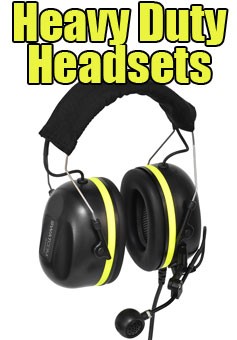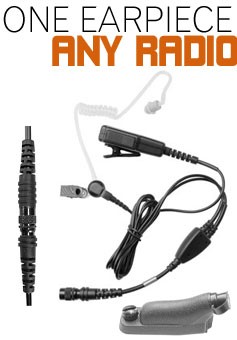
Acquiring an Ofcom license for a two-way radio may seem like an intimidating process, however, it is simpler than it appears. This guide is designed to provide clear, step-by-step instructions to help you navigate the process easily.
By the end, you'll be able to communicate securely and legally on your two-way radio, as per the regulations set by the Office of Communications, better known as Ofcom. Let's embark on this journey together to ensure you are rightfully licensed to operate your two-way radios in the UK.
Why would you need a radio licence
Obtaining a radio licence is crucial for anyone using radios within a specific area or building. The primary reason for this is to prevent congestion on the airwaves. With a vast number of radio users transmitting on a multitude of frequencies, congestion is a common issue that can lead to interrupted transmissions, significantly impairing communication.
Furthermore, a radio licence helps ensure secure transmissions. In the absence of a license, transmissions could be open to eavesdropping, risking the confidentiality of your communication. Therefore, a radio licence not only guarantees uninterrupted and efficient communication but also contributes to the security of your operations.
Channels vs Frequencies
One common mistake often made in the realm of radio communication is the confusion between channels and frequencies. In essence, a frequency is a specific range in the spectrum that allows radios to communicate. The frequency is allocated to a channel, facilitating communication if the radios are tuned to the same frequency.
Each channel will have a unique frequency assigned to it. Simplistically, think of a frequency as the 'address' that a radio tunes into, and the channel as the 'house' at that address. The confusion arises because people often interchange these two terms, but understanding the distinction is crucial for efficient and effective radio communication.
Types of Ofcom licence
There are various types of Ofcom licences available, each catering to different needs and applications. These include a Simple UK Light licence, Simple Site Light licence, Suppliers' Light licence, Area Defined licence and Technically Assigned licence. Most people will use a Simple UK Light licence or a Area Defined licence.
Simple UK Light licence
The Simple UK Light licence is an excellent choice if your operation requires coverage over a smaller area. This license allows the use of hand-portable or mobile radio equipment anywhere across the UK, tapping into nineteen frequencies spread across four Business Radio frequency bands.
However, it's important to note that licencees must self-coordinate with each other for the use of these frequencies. Unfortunately, this type of licence does not provide coverage for the use of a base station.
Priced at £75, this licence is valid for a period of five years. At Radio Trader, we can supply both handheld and vehicle-mounted radios designed to operate on these frequencies.
Simple Site Light licence
The Simple Site Light licence is your go-to option if you intend to operate a radio system equipped with a base station and mobile stations over a limited area, typically one kilometre or less. This licence type is frequently employed for radio paging systems and offers a variety of frequencies for use.
However, licenees must self-coordinate with other Simple Site Light users to manage the frequencies efficiently. The Simple Site Light licence proves particularly advantageous for entities such as factories, nursing homes, or housing associations. In terms of cost, the licence fee stands at £75 per site, valid for a duration of five years.
Suppliers' Light licence
The Suppliers' Light licence is a specialized provision designed for servicing, repairing, and hiring out business radio and marine equipment. This licence type is particularly beneficial for customers using our short-term radio hire services, as they are not required to worry about having a licence of their own.
The privileges granted under this licence include the ability to hire both business radios (including trunked business radios) and/or radio paging equipment to customers for up to a year, allocating such equipment to customers awaiting their Business Radio licences for up to three months (a process referred to as 'parking'), and demonstrating said equipment to potential customers for up to eight days.
A range of frequencies are available for use under this licence, shared with other users holding the same licence type. The Suppliers' Light licence is priced at £75 and is valid for a period of five years.
Area Defined licence
If your operation demands exclusive use of a frequency across any designated area, ranging from a 50km2 grid to a county or even the entirety of the UK, you may find the Area Defined licence to be the most appropriate choice.
This type of licence, procured from Ofcom, grants exclusive access to a specific radio channel within the specified area. However, it is noteworthy that the availability of UK-wide channels can be very limited.
Therefore, it is always advisable to check with Ofcom in advance regarding the availability of such channels. This level of exclusivity is particularly beneficial for larger operations where the potential for frequency interference could significantly disrupt communications.
Technically Assigned licence
The Technically Assigned licence is an extremely flexible option, authorising the use of a wide array of business radio equipment. This type of licence is characterised by its assortment of frequencies and expansive coverage areas, which can range from small scale, such as within a building, all the way up to large scale, like county-wide coverage.
The flexibility of the Technically Assigned licence allows for a tailored communication solution that can adapt to the specific needs of your operation. Due to its ability to cater to a wide spectrum of requirements, this licence type is ideal for businesses with complex, ever-changing demands.
Please note that the cost and validity period for this licence type may vary and it is advisable to check with Ofcom for the most accurate information.
Licensed vs licence-free
While both licensed and licence-free radios serve communication needs, they each have distinct characteristics.
Licence-Free Radios
Licence-free radios, most commonly operating on the 446 MHz band, provide a cost-effective solution for short-range communications. They are ideal for recreational use or small-scale operations.
However, one significant drawback is the potential for frequency conflict. Given that these radios operate on a shared frequency band, in areas with a high number of licence-free radio users, you might experience interference from other devices. This can lead to disrupted communication and a lack of privacy in your transmissions.
Licensed Radios
On the other hand, licensed radios offer a more robust solution for professional and large-scale operations. When you purchase a radio licence, you are allocated a dedicated frequency which isn't available for use by anyone else.
This drastically lowers the chance of encountering conflicts or interference from other radios in your area, thus ensuring clear and uninterrupted communication. While there is an associated cost for obtaining a licence, the benefits of reliable and secure communication make it a worthwhile investment for many businesses.
Applying for Two-Way Radio Licences
All applications for two-way radio licences for business purposes are handled through Ofcom, the UK's communications regulator. The application process can be conducted online via their website.
This may seem complex, especially if you're new to the world of radio communication. But don't worry—you're not alone! We understand that the process can be daunting and that's why we're happy to assist.
We can handle the application process on your behalf, ensuring that everything is in order and submitted correctly.
-

Licenced Two Way Radio (Kirisun DP405) with Earpiece
The Kirisun DP405 emerges as a comprehensive solution for professional comm...
-

Licence Free Two Way Radio (Kirisun DP405S) with Earpiece
Discover the Kirisun DP405S, a license-free digital 446 radio with 16 pre-p...
-

Kirisun DP405 / DP405S 6 Bank Charger
Streamline your communication management with the Multi-Unit Charger, a mus...





















